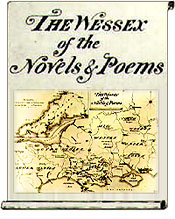 |
|
|
|||||||||||||||||||||||||||||||||||
Good writing, as many a literature professor has observed, conveys a strong sense of place. While characters and their actions may drive the plot, the action works better if everything happens in a recognizable, or at least easily imaginable, landscape. This landscape may be a real one, or the writer may just make it up. An example of pure invention occurs in Daniel Defoe’s 1719 book Robinson Crusoe. Widely identified as the first modern English novel, this book describes for much of its length the relationship between a man and a place — an imaginary island. Crusoe spends a large part of the book in solitary activities such as building a stockade, hunting for goats, farming, and so forth. Defoe describes the island’s geographic features in detail as Crusoe goes about his tasks. The novel’s full title as first published not only gives the island’s precise location, but also throws in a good bit of the plot: The Life and Strange Surprizing Adventures of Robinson Crusoe, of York, Mariner: Who lived Eight and Twenty Years, all alone in an un-inhabited Island on the Coast of America, near the Mouth of the Great River of Oroonoque;
Descriptions of nonexistent places are routine in literature, but only a few authors have taken the fantasy to the point of charting their imaginary lands. J.R.R. Tolkien, like his friends C.S. Lewis and Charles Williams, wrote allegorical novels about the struggle between good and evil. Unlike Lewis or Williams, Tolkien took pen to paper and created detailed maps of “Middle-Earth.” Though Tolkien modeled his maps on medieval cartography, complete with little bumps to show mountains and place names in carefully lettered uncials, his maps show a very modern sensibility of projection and form, though they lack a scale.  Other creators of imaginary landscapes have had maps made for them by commercial artists and devoted fans. Illustrators have prepared precisely detailed and (one supposes) accurate maps of such non-existent lands as C.S. Lewis’s Narnia, J.M. Barrie’s Never-Never Land, Frank Baum’s Oz, Thomas Hardy’s Wessex, Anne McCaffrey’s Pern, Earthsea from the imagination of Ursula K. LeGuin, and innumerable other imaginary worlds. For literary purposes, an imaginary landscape is much more versatile than a real one because geography can be specifically created to reveal information about the characters and plot. In some cases this is a deliberately transparent attempt at moral instruction, as with John Bunyan’s 1675 allegory Pilgrim’s Progress. Bunyan describes how Christian, his hero, journeys from the City of Destruction to the Celestial City by way of the Slough of Despond and the temptations of Vanity Fair. But usually the attempt is less instructive and more entertaining. In the 20th century H.P. Lovecraft created Arkham, an eerie Massachusetts town with shadowy streets and disturbingly pitched roofs, rife with a hidden evil that lurks at the edges of consciousness. The geography of each of Italo Calvino’s 20 “Imaginary Cities” reflects the city’s character and the character of its inhabitants, while Jonathan Swift’s islands of Lilliput, Brobdingnag, and Laputa exemplify various unpleasant aspects of human nature.  Geography can also be used to symolize a specific character or indivdual character trait. Thus in James Thurber’s The 13 Clocks, the evil Duke lives in a forbidding castle with many dungeons and twisting corridors -- the castle exemplifies the Duke’s warped and malicious nature. Tolkien’s antisocial dragon Smaug inhabits a solitary mountain surrounded by impenetrable forest, a geographic expression of his personality. Especially in fairy-tales, characters require appropriate backgrounds, even though in theory it is equally possible for an evil duke to live in a double-wide house trailer just outside of Tampa or for a fierce dragon to crouch under a high-rise in midtown Manhattan. Copyright © 1999, 2000 media.org. |
||||||||||||||||||||||||||||||||||||
|


